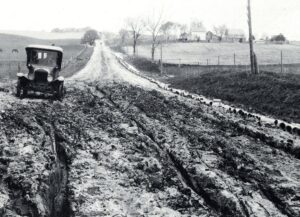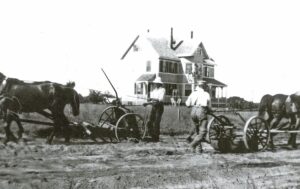On Route 6 in Eastham, across the road from Buddha Bob’s, sits a plain shingle-sided house. It’s a classic Cape house in many respects: its door faces east, it has a central chimney and hearth, and its south wall is lined with windows to let in the sun.

Its modest appearance, however, belies a storied history. One of the most influential people ever to live on the Outer Cape called this simple house home.
Gustavus Swift, born in 1839, was described by relatives as a smart, quiet, and industrious kid, according to biographer Thomas Goodspeed. He was the ninth of 12 children of a Sagamore family. He began working when he was nine years old for his brother Noble, the village butcher, for a dollar per week.
Butchery clearly appealed to the young Cape Codder: he dropped out of school at 14, and at 16, the story goes, his father lent him $20 to buy a cow. Swift then slaughtered the heifer and sold it piecemeal around the village, making $10 in profit.
This strategy became Swift’s business model. He bought livestock in Brighton, slaughtered and butchered the animals, then sold their meat door-to-door over the course of the week.
As Goodspeed has it, by 1859 Swift had accumulated a decent sum of money and decided to establish himself as a village butcher somewhere. He chose Eastham.
Gustavus Swift and his brother Nathaniel arrived in town in the winter of 1859. They bought a house from Joshua Knowles, the son of a local builder, and began selling meat out of their “butcher shop” — really a horse-drawn wagon. Eastham was a tiny community at the time, so with little competition the two brothers were quick to establish themselves. At the start of the week, they would load their wagon with meat and travel up Cape toward Sandwich, then turn around and head back to Provincetown, selling meat along the way.
The brothers slaughtered and dressed their livestock in a now-vanished slaughterhouse near Eastham’s Thumpertown Beach. This building likely was located near the road that today bears their name — Swift Road.
Eastham was not only the locus of Gustavus’s professional life. It was there that he met his wife, Anne Higgins.
The Higginses were one of the seven original families to settle in Eastham in the 1640s. Anne’s relative, Solomon Higgins, led a local militia during the Revolutionary War that participated in Henry Knox’s campaign to transport cannons from Fort Ticonderoga to Boston in the middle of winter, according to historical records.
While there are no accounts that describe how Higgins and Swift met, we know they married barely a year after Swift moved to Eastham. The couple briefly lived in North Eastham and then moved to Barnstable. Nathaniel stayed in town a while longer but soon left as well, selling the house in 1863, according to My Father and My Mother, a book by the Swifts’ daughter, Helen.
Swift’s ambitions moved the couple and their growing family off Cape to Clinton, then Lancaster, then Albany, N.Y., then Buffalo. Swift was chasing the expanding meat industry westward and revolutionizing it as he went.
In 1875, the Swifts made their last move, landing in Chicago. By the middle of the 19th century, thanks to its large population and vast rail network, Chicago had become the home of the nascent meatpacking industry. Farmers would ship their livestock to the city, where workers in processing plants butchered it for local markets or preserved it for sale elsewhere. In 1870, three million cows and pigs were processed in the city. By 1900, that number was 12 million.
Swift’s ventures in Chicago’s stockyards could fill books. After incorporating as Swift & Company in 1885, he acquired a design for a refrigerated railroad car using ice stashed in the roof instead of pressed against the meat. Though there were other refrigerated cars at the time, it was a method that better preserved the quality of the meat.
Now, instead of shipping livestock to the Eastern cities, his invention allowed Swift to send only the edible parts, saving money and streamlining transport. Wider profit margins made cows from the Midwest far more valuable for meatpackers, who in turn paid more for farmers’ cattle, expanding the cattle industries in those states and bolstering their economies while also making meat cheaper for Easterners.

No one made more money than the meatpackers themselves, according to Goodspeed.
Swift’s true gift was an ability to find profit where few others did. Swift & Co. were also pioneers in the byproducts industry and quickly learned how to turn previously unusable parts of the animal into soap, fertilizer, gelatin, and glue.
He made a fortune at it, according to Goodspeed. Swift & Co. became one of the “Big Six” companies that controlled Chicago meatpacking. By the time Swift died in 1903, his company was doing about $160 million in business annually. He left a personal fortune worth between $7 million and $10 million, or $245 million to $350 million in 2023 dollars. His company, meanwhile, was worth $25 million when he died, or nearly $875 million today.
Swift was a philanthropist. He funded the construction of the Annie May Swift Hall at Northwestern University, named for his daughter, and he donated the original $25,000 required to establish the Hyde Park YMCA. Goodspeed wrote that a guest at Swift’s funeral said that “his name is hidden in the cornerstones of a thousand churches and colleges.”
He was also not a rule follower. Writing about Swift in the Autumn 2006 issue of the Cape Cod Voice, Bridget McDonald put it this way: “Arbiters of industry forged the rules, and Swift was prepared to bend all of them.”
Swift & Co. was the focus of one of the earliest antitrust cases in the United States. The “Big Six” Chicago meatpackers, or “Meat Trust,” controlled half the national market and agreed not to compete with one another, according to the case record. This deal allowed them to bully railroad companies and other side industries by threatening to pull their business if their demands were not met. The Teddy Roosevelt administration eventually sued the companies for this monopolistic behavior in 1905 and won. The case, Swift & Co. v. United States, helped usher in a wave of antitrust cases in the early 20th century.
The meatpacking industry was famously dangerous for workers. Often recent immigrants, many of them children, were easily exploited to work long hours for little pay. And at the turn of the 20th century, journalists began documenting those dangers.
In 1904, writer Upton Sinclair spent seven weeks gathering information while working in meatpacking plants in Chicago. He was also working for the socialist newspaper Appeal to Reason. His experience informed a fictional series, which the newspaper published in serial form in 1905. The next year it was published by Doubleday as The Jungle, and it has been in print ever since.
What Sinclair wrote horrified the public. The Jungle described how machines built to slice meat would easily do the same to a human hand, and floors caked with blood and bile became breeding grounds for disease. Readers learned that moldy meat, dead rats, and the water workers washed their hands in would all get tossed into the same grinder, mixed into sausage filling, and sold to customers.
The book inspired the passage of the Federal Meat Inspection and Pure Food and Drug Acts to institute quality controls. The latter of these two acts became the cornerstone of the Food and Drug Administration.
After the Swifts left Eastham, the house Gustavus and Nathaniel had lived in ran through a few owners before falling into disrepair by the 1930s. It was eventually purchased and repaired by the Daley family. Marca Daley grew up on the property, one house over from the Swifts. Today, that house is a museum run by the Society and known as the Swift-Daley House and Daley is its archivist and co-curator.
Gustavus’s son Louis once wrote that his father’s prudence and efficient business practices were cultivated in the “miserly sands of Cape Cod.” Good and bad, Swift’s legacy was born right here. Evidence of these early entrepreneurs’ work is probably still with us, though hidden from view, Daley figures, in the form of a deposit of cow and pig bones from the Swifts’ operation somewhere near Thumpertown Beach.
Editor’s note: an earlier version of this story erroneously identified Marca Daley as the president of the Eastham Historical Society. She is the archivist and co-curator of the Swift-Daley House museum.



